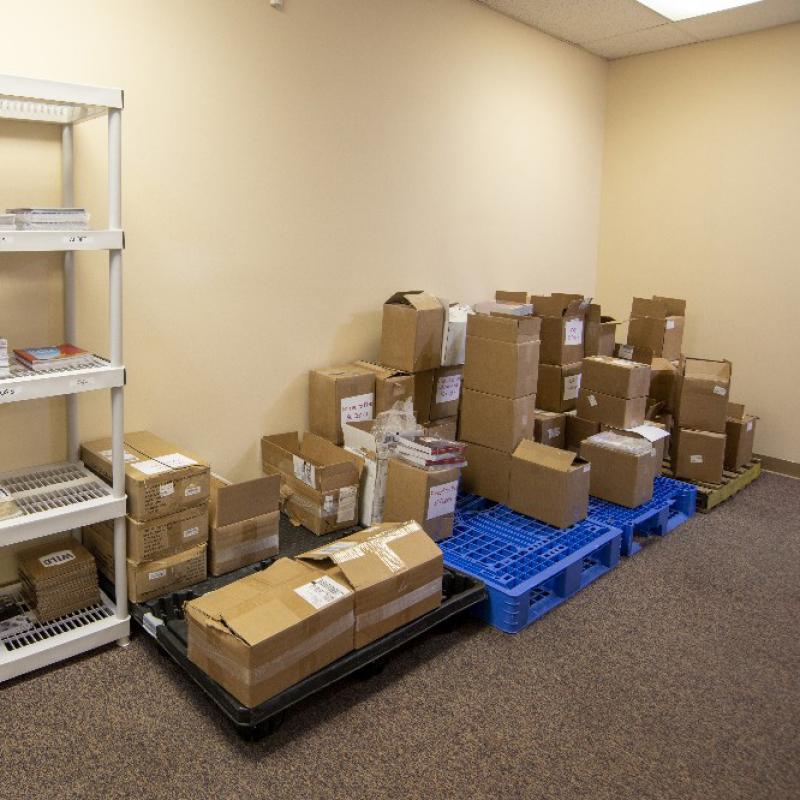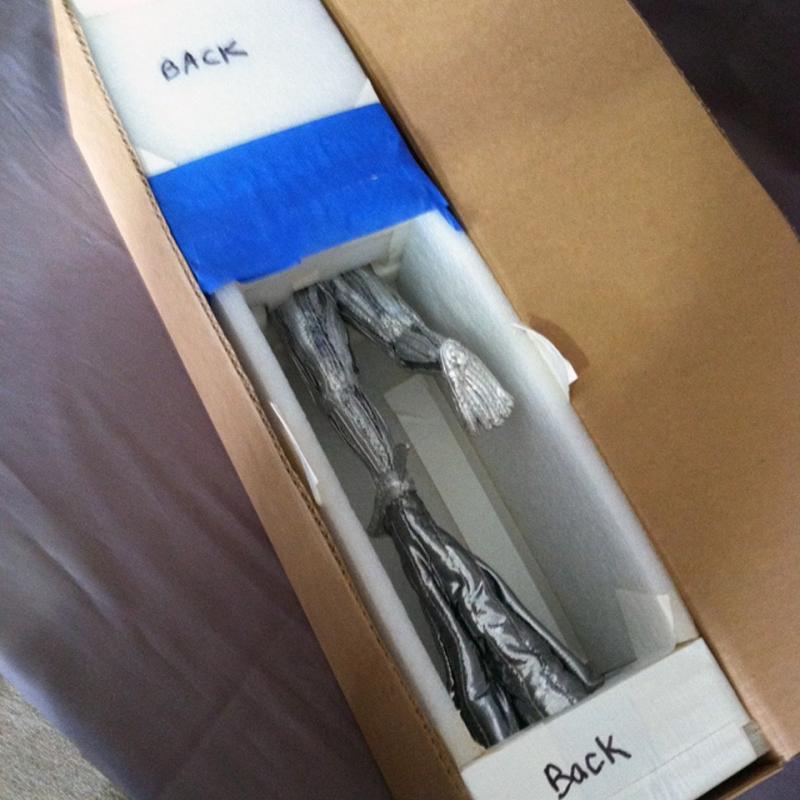This article was originally published in the SAQA Journal (2020 #4)
Part of being a professional artist is having the follow-through needed to professionally ship your work. Not only does this important step ensure the safety of your art, it can make an impression on the recipient that may in turn impact how they handle your work. The different options for packing and shipping can seem overwhelming at first, but there are basic guidelines to follow that make the process easier and help ensure that your piece arrives safely at its destination.
Packing artwork
Choosing your box wisely is an important first step. The size of your package matters in terms of protecting your piece and managing your shipping costs. Your artwork should fit snugly inside your box without being either too cramped or having room to slide around. Either situation can result in your piece arriving with bent edges, creases, or other damage. Check out SAQA’s video at www.saqa.com/packing for guidelines on how to properly pack an art quilt.
Shipping companies and insurers may not be responsible for damage caused by poor packing. Make sure you choose a box that is at least sturdy enough to handle some impact from being dropped, bumped, or piled with other packages. You may need something even sturdier if your art-work has fragile components or if the box needs to be used more than once.
When you ship to a buyer or collector, your box will need to be strong enough to make one trip. However, when you ship to an exhibition, speak with the person who manages the artwork. Ask if your box will be used to ship your piece between venues for the duration of the exhibition, or if it will be kept and used to return your artwork once the exhibition has ended. If the answer to either of these questions is yes, a sturdier box with adequate padding inside may be necessary.
In most cases, SAQA Global Exhibitions does not reuse your shipping box for either purpose. The box and any of the packaging it contains will not be sent back to you. There is no need to overspend on a box that will only be used once, and a larger box may cost more to ship regardless of weight. Note: SAQA regional exhibitions may handle packing materials differently, so ask each time you take part in a regional exhibition.
Once your box has been packed for shipping, it is equally important to clearly mark it. This helps locate your shipping box if it gets lost or misdirected. While it’s great to use recycled boxes to save money or to have a smaller environmental impact, make sure that your package stands out. Lost packages have been quickly found in warehouses, trucks, and on video feeds when their exteriors are visually distinctive, such as being marked with brightly colored tape or large, bold lettering.
International shipping
Choose your carrier with care too, particularly if you have a tight deadline to deliver your work. While the local postal service generally costs less and has fewer problems with customs, during the COVID pandemic we saw that the United States Postal Service (USPS) was overwhelmed and could not be relied on to quickly move mail.
International shipping has more rules and regulations to follow. Some countries have restrictions for the maximum length and girth of packages, which may dictate whether your quilt needs to be rolled or folded. Look up these restrictions before you choose your box and pack up your quilt.
Regardless of size, expect to pay more to ship your box internationally, but don’t be tempted to cut corners or break laws to save money. When shipping to the United States, no duty is charged on artwork. When shipping internationally, you must properly identify and declare the actual market value of your artwork on all customs declaration forms. Declaring less than the full market value may result in fines, seizure of your artwork, or other penalties imposed by customs officials in the importing or exporting countries.
Non-U.S. SAQA members who ship their artwork to the United States for a SAQA Global Exhibition may receive reimbursement for a portion of their shipping expenses by filling out and submitting the form at www.saqa.com/reimbursement.
Avoid the temptation to try to “trick” customs by under-declaring the value of your art or labeling it as fabric samples or cloth. Doing this may actually trigger customs being charged. However, also know that even if you fill out your forms correctly, you may still be charged customs fees based on the whims of the specific customs agent who handles your package.
When SAQA returns your artwork at the end of a global exhibition, the full market value of each work will be declared. Fewer issues arise with return shipping when the forms are completed correctly for the original shipment. Properly declaring your artwork helps to protect it and is one of the expenses of being a professional artist.
Carefully research and follow local customs laws and regulations for the countries that you send work to and from. Before shipping any piece of art, check to make sure that every material used, including embedded or attached objects, is permitted to be shipped according to the rules of both your carrier and the customs regulations of both countries. Failure to do so may result in your art-work being seized or possibly even destroyed.
When shipping entire exhibitions or more expensive works for temporary display, you may wish to consider using an ATA Carnet, which is a customs and temporary export-import document, or hiring a broker who handles temporary import bonds. These options add expense, but you won’t be surprised with large customs fees. A broker can also help with any issues that may arise along the way.
When shipping from the United States to another country, you are required to file an Electronic Export Information (EEI) form with the U.S. Census Bureau prior to shipping if your artwork is valued at $2,500 or more. You are also required to file an EEI if you are returning artwork of the same value from the United States to locations overseas.
All EEI information is provided to the U.S. Cen-sus Bureau and is used for export compliance and governmental reporting. This does not apply for shipping to Canada.This is an instance where choosing the right carrier can make a big difference. The USPS will not file an EEI for you, and you will therefore need to take care of this yourself. FedEx will permit you to file through your online account for a minimal fee.
Find your fit
Do your research to see what each carrier offers. While it’s true that you get what you pay for, discounts are possible. Many postal services, FedEx, and UPS offer significant savings if you open an online account and create your own labels.
Regarding price, the size of your package matters more than how much it weighs. Most shippers use dimensional weight, or DIM weight. This means you may be charged based on the dimensions of your box rather than its weight. For example, a one-pound quilt can cost the same as a thirteen-pound quilt if it is shipped in a four-foot-long tube. Depending on how large your piece is, you may want to determine if it can be safely folded instead of rolled. Though the care of your quilt takes precedence, this is where you can save money if you package your art quilt properly.
When shipping with FedEx and UPS, you can also save money by dropping your package off at a business location instead of having it picked up at your residence. It doesn’t hurt to call and ask if they are willing to give you a better rate.
Signature & insurance
Signature service can cost up to $5 more, but it can be well worth it to protect your artwork. Without signature required, UPS and FedEx will leave your artwork on the doorstep of a residence regardless of the weather, though they will not leave it at a business address unless someone is present. USPS will simply leave your artwork even if no one is there, whether it’s on a front porch or outside of a business in a busy shopping center. It is always best to coordinate with the recipient when deciding on the best carrier and shipping options to protect your art.
Having the right insurance is also important, but it is possible to overinsure. If you regularly ship to exhibitions or collectors, find out if your homeowners or business insurance will cover your work in transit, or if they offer a policy that will. If your work is already covered, there is no reason to buy separate, one-time insurance through your carrier. You won’t receive a double payout if any-thing happens.
Also, make sure that you get what you pay for. It is a common misperception that FedEx offers insurance on packages. FedEx will ask you to declare a carriage value, which increases your shipping costs and limits their liability, but it is specifically not insurance. Some carriers will allow you to declare a higher carriage value and charge you accordingly, but limit their liability to much less. Carriers may also have clauses which exempt them from liability for certain classes of items, including artwork. Researching your carrier’s policy on insurance and liability can save you significant heartbreak and frustration if your artwork is lost.
Conclusion
While mailing your artwork always involves some risk, there are simple steps to greatly minimize it. Find out what kind of packaging will best protect your piece and whether it will be used only once or multiple times over several years. Make it stand out visually, and label it properly. Research important details, including how various postal carriers will handle your package, what types of insurance coverage are available, and any customs or postal regulations that directly affect your shipment.
Still not sure about the best way to send your artwork for a SAQA global exhibition? Contact Bill Reker, Director of SAQA Global Exhibitions, at exhibitions@saqa.com, and he will be happy to guide you through the process.



